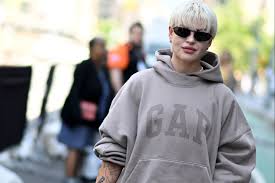The collaboration between Kanye West’s Yeezy brand and Gap was an unforeseen yet revolutionary pairing in the fashion industry, blending the avant-garde with accessibility. Yeezy, known for its bold, futuristic, and often minimalistic approach to clothing, contrasted sharply with Gap’s reputation as a longstanding purveyor of practical, everyday apparel. Yet, the excitement around Yeezy Gap has been palpable since its inception. The partnership’s announcement stirred expectations within both fan bases and the broader fashion world, hinting at a potential transformation of not only the participating brands but also the wider industry.
Revolutionizing Streetwear
At the heart of Yeezy Gap is a pioneering vision that reshapes how streetwear is perceived. Yeezy Gap Hoodies has distinguished itself with a design philosophy that avoids loud logos or excessive embellishments, focusing instead on unique silhouettes and textures. The creative direction, steered by Kanye West’s exacting eye, introduces high-fashion concepts into everyday wear, making items feel like rare art pieces. This vision isn’t just about clothing—it’s about merging Kanye’s artistry with the simplicity Gap champions, producing streetwear that feels new, personal, and raw.
Breaking Traditional Fashion Norms
Yeezy Gap challenges longstanding boundaries between high-fashion exclusivity and accessible, everyday wear. Traditionally, high-end streetwear remained out of reach for many consumers. With Yeezy Gap, the lines are blurred, making once-elusive designer-inspired pieces accessible to the masses. This disruption of norms has not only influenced how streetwear is defined but has also driven competing brands to rethink their approaches to casual luxury. By merging couture-inspired silhouettes with affordability, Yeezy Gap repositions itself as a brand that democratizes luxury without sacrificing uniqueness.
The Allure of Minimalism and Utility
A standout characteristic of Yeezy Gap lies in its commitment to minimalism and utility, eschewing ornate detailing in favor of sleek, versatile forms. This minimalist approach taps into a growing demand for functional yet fashionable attire that fits various lifestyles. With items like the iconic “Round Jacket,” the collection embodies practicality without forfeiting style. The utilitarian aesthetic appeals to a broad demographic, resonating especially with those who favor a refined, stripped-down wardrobe that still captures attention. This minimalist ethos reflects modern sensibilities, where function meets form in pieces that remain relevant over time.
Influence on Consumer Culture and Hype Cycles
In the modern fashion ecosystem, Yeezy Gap’s approach to releasing items has significantly impacted consumer culture. By strategically using limited drops, the brand generates buzz, encouraging consumers to embrace a ‘get-it-now-or-never’ mentality. Yeezy Gap’s scarcity-driven model stokes a sense of urgency that fuels the secondary market, where exclusivity and demand collide. This hype cycle, reminiscent of sneaker culture, fosters a community that sees Yeezy Gap as more than clothing—it’s an experience, a movement. Such an approach shifts fashion consumption from mere acquisition to something more experiential and emotionally charged.
Sustainability Considerations in Yeezy Gap
The Yeezy Gap partnership also draws attention to sustainability, a topic that has become a priority in fashion. While not every Yeezy Gap item is marketed as sustainable, the collection’s focus on minimalist designs and durability points toward an intention of reducing waste. Through considered production practices and mindful material selection, Yeezy Gap aligns itself with a growing global trend of eco-consciousness. The emphasis on longevity over disposability suggests an alignment with values of sustainable consumption, positioning Yeezy Gap as a potential leader in environmentally responsible fashion.
Yeezy Gap’s Effect on Gap’s Brand Identity
For Gap, the collaboration with Yeezy has revitalized a brand that, in recent years, struggled to capture the attention of younger, trend-savvy audiences. Yeezy Gap allows Gap to present itself as not only a provider of basic essentials but also as a player in the high-stakes world of modern streetwear. However, this shift is not without challenges; Gap now faces the task of balancing its traditional image with the high-fashion allure of Yeezy. This dual identity could either strengthen Gap’s appeal across generations or risk alienating long-standing customers if not carefully managed.
Long-Term Impacts on the Fashion Industry
Yeezy Gap’s success underscores a new era for designer-retailer collaborations, paving the way for future ventures that unite high-fashion with mainstream brands. The impact of this partnership stretches beyond sales, as it has inspired similar collaborations and heightened expectations for what accessible fashion can achieve. Looking forward, Yeezy Gap’s success might set a precedent for other designers, encouraging a push toward minimalist, functional fashion that balances exclusivity with accessibility. This paradigm shift could redefine fashion’s future, emphasizing creative partnerships that elevate brand legacies while meeting the evolving demands of global consumers.


